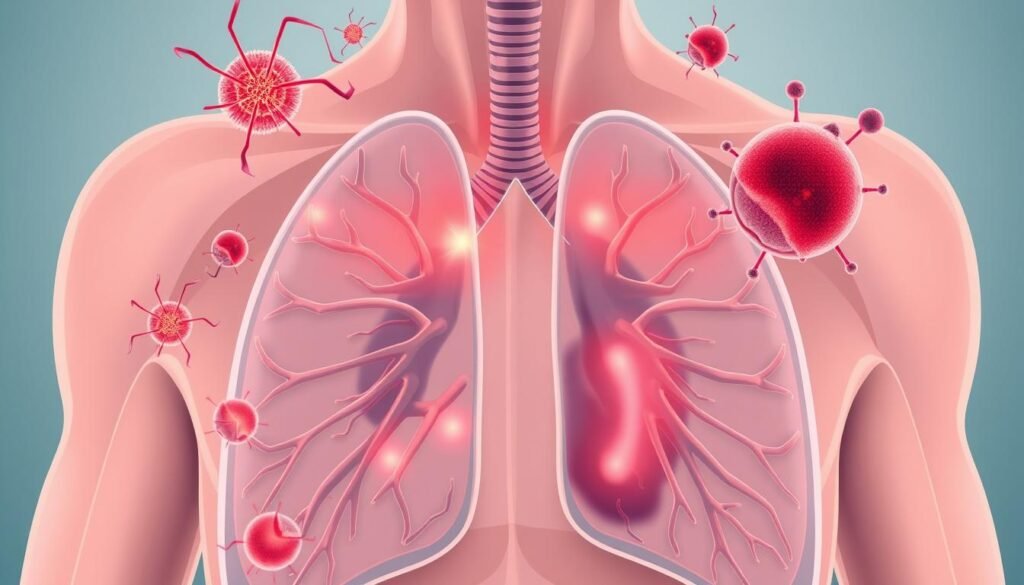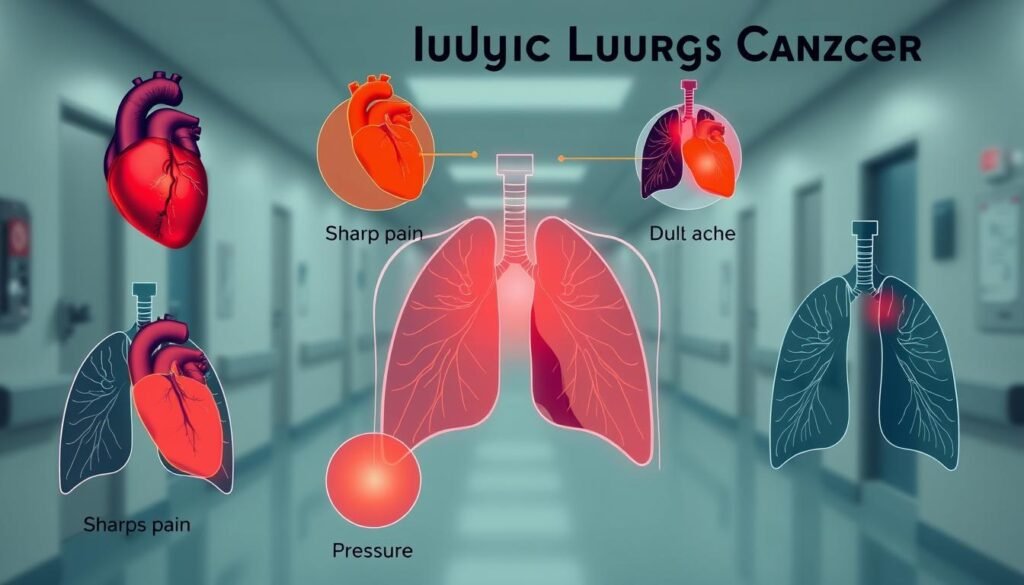About 20% to 40% of people with lung cancer feel chest pain. This makes it a common symptom of the illness. Lung cancer is one of the leading types of cancer in the world. The link between it and chest pain can worry a lot of patients. This piece looks into why lung cancer might cause chest pain.
It also talks about how to handle these symptoms and when it’s important to get medical help. Knowing about these links is key for anyone dealing with lung cancer. It helps them understand what’s happening to their body.
Key Takeaways
- 20-40% of individuals with lung cancer are likely to experience chest pain.
- Chest pain can manifest as dull aches, sharp pain, or a burning sensation.
- Tumor location and size influence the type and intensity of chest pain experienced.
- Management of chest pain may involve medications, therapies, and lifestyle adjustments.
- Prompt reporting of new or worsening chest pain is essential for lung cancer patients.
Introduction to Lung Cancer and Chest Pain
Lung cancer is a major health issue, leading in cancer deaths for both genders. People often feel chest pain symptoms and think it’s not serious. Knowing these can mean lung cancer is vital. Lung cancer affects over 80% of patients with symptoms like ongoing cough, weight loss, and feeling tired.
Smoking tobacco is a key cause, responsible for 90% of men’s and 80% of women’s cases. Secondhand smoke also increases the risk significantly. Having relatives with lung cancer, or being exposed to asbestos and polluted air, raises your risk too.
It’s crucial to catch lung cancer early to improve chances of treatment. If you have lasting symptoms, get checked by a doctor. Learning about introduction to lung cancer and symptoms of lung cancer helps you make smart health choices. This awareness can ensure important signs don’t get ignored, possibly pointing to lung cancer.
What is Lung Cancer?
Lung cancer leads in cancer deaths across the globe. Knowing about lung cancer starts with its biological nature. It mostly involves abnormal cells growing out of control in the lungs. These cells form tumors which can hurt normal lung functions. This leads to several symptoms that can affect daily life.
When talking about lung cancer, we often mention two main types. These are non-small cell lung cancer (NSCLC) and small cell lung cancer (SCLC). NSCLC is more common, making up about 85% of all cases. Each type behaves differently, has various treatments, and affects patients differently. This information helps us grasp the severity of lung cancer.
Lung cancer holds the rank as the second most common cancer in the U.S. Smoking is the top cause of lung cancer. Risks also come from secondhand smoke, past radiation therapy, radon gas, harmful substances, and family history. These factors play a big role in lung cancer risk.
Often, lung cancer isn’t caught early because signs don’t show up right away. Symptoms like chronic cough and shortness of breath usually appear once the cancer has grown. Other problems, such as pain or fluid buildup, also occur as it progresses.
To catch lung cancer early, high-risk people should get screened regularly. Tests like imaging scans and biopsies are key in these check-ups. Knowing about the types of lung cancer and what they mean is vital. It helps in preventing and managing the disease better.
Common Symptoms of Lung Cancer
Lung cancer often moves forward without obvious signs. Knowing the common symptoms helps in spotting it early. This early detection can lead to more effective treatment options. The key symptoms include:
Persistent Cough
A persistent cough can be an early sign of lung cancer. This cough might last more than eight weeks and get worse. People might also cough up blood, a condition known as hemoptysis.
Shortness of Breath
Feeling short of breath is another serious symptom. It can happen during simple activities or even at rest. This could point to lung problems that need quick check-ups.
Unexplained Weight Loss
Sudden weight loss without trying is a major red flag. It often comes with losing interest in food. These signs could mean the cancer is advancing. Catching it early is critical.
If you understand these symptoms, you could catch lung cancer early. When found early, there are more ways to treat lung cancer. Visit this resource for more about lung cancer symptoms.
Understanding Chest Pain: General Overview
Chest pain varies a lot among individuals, making it hard to understand in lung cancer patients. The pain can feel dull and aching or sharp and stabbing. This difference greatly impacts life quality, making it key to identify the pain correctly for proper management.
Chest pain changes with daily activities. Actions like deep breathing and coughing can make it worse. The pain’s nature changes with physical activity or posture changes. Also, pain’s location is crucial; pain on one side signals different issues than pain in the chest center.

For lung cancer patients, chest pain can indicate serious problems. It could come from related conditions, requiring careful checks. Knowing this helps catch and treat issues early, improving patient outcomes.
Does Lung Cancer Cause Chest Pain?
Chest pain is a major worry for people with lung cancer, particularly in the later stages. About 46% of patients deal with chest pain or painful breathing. This is often due to tumors pressing on nearby tissues and nerves. Many ask, does lung cancer cause chest pain? Yes, it does. Several factors lead to discomfort, which can indicate lung cancer pain.
In those with non-small cell lung cancer (NSCLC), a persistent cough without clear cause is common. It affects around 59% of people. Shortness of breath also makes things hard for 61% of patients. This can make chest pain worse, especially during coughs or deep breaths.
With small cell lung cancer (SCLC), chest pain often gets worse as the cancer grows. Symptoms show up later. Patients feel more pain when coughing, laughing, or taking deep breaths. It’s important for doctors to see these signs. They need to connect them to lung cancer to help patients well.
Knowing how lung cancer and chest pain are linked can improve symptom management. If you have chest pain, tell your doctors. This lets them check you fully and may change your treatment if needed.
| Symptom | Non-Small Cell Lung Cancer (NSCLC) | Small Cell Lung Cancer (SCLC) |
|---|---|---|
| Persistent Cough | 59% | Later Stages |
| Chest Pain | 46% | Worsens upon Coughing |
| Shortness of Breath | 61% | Dependent on Tumor Stage |
| Bone Pain | 33% (indicative of advanced stages) | Uncommon |
Types of Chest Pain Associated with Lung Cancer
Chest pain in lung cancer patients varies widely, affecting life quality. It’s crucial to recognize the different types of chest pain. This knowledge helps patients and doctors manage it effectively.
Dull Aches vs. Sharp Pain
Chest pain falls into two main categories: dull aches and sharp pain. Dull aches feel like pressure or heaviness, often due to tumors pressuring tissues. In contrast, sharp pain is more immediate, caused by irritation or inflammation of the lung’s linings.
Knowing whether pain is dull or sharp helps identify underlying issues. For accurate diagnosis and treatment, seeing a healthcare professional is crucial.
When Chest Pain Worsens
Increasing chest pain might mean the disease is advancing. It can get worse with deep breaths, coughing, or moving. Knowing when pain increases helps patients talk to their healthcare providers.
It’s important to monitor chest pain and alert a doctor if it gets much worse. For extra details on lung cancer-related chest pain, check out this article on lung cancer symptoms.

Other Possible Causes of Chest Pain
Chest pain means many health problems. While lung cancer is a major worry, knowing other causes is key. Different health conditions can cause the same symptoms. This shows why thorough check-ups are a must.
Heart-Related Issues
Heart problems are a main reason for chest pain. Issues like angina and heart attacks might feel like lung cancer warning signs. Knowing these heart problems helps get people help fast. High blood pressure, high cholesterol, and family heart disease history heighten these risks.
Lung Conditions Beyond Cancer
There are lung issues other than cancer that cause chest pain. COPD and pneumothorax are examples leading to discomfort. These affect breathing and cause symptoms that seem like lung cancer. Knowing about these conditions helps recognize different chest pain reasons. It underlines the need for detailed health checks.
Management of Chest Pain in Lung Cancer Patients
Effective management of chest pain in lung cancer patients requires teamwork. It’s crucial for patients to share how they feel. They should describe their pain’s nature and intensity. This helps tailor their treatment plan, including pain relief options that match their needs.
Several methods can ease lung cancer pain. These include medications like opioids and non-opioids. Physical therapy helps too, improving movement and lessening pain from staying still too long. Plus, changing lifestyles to manage stress and relax can improve patients’ comfort.
Centering care around the patient boosts their life quality. Guidelines for managing lung cancer symptoms give useful advice for easing chest pain and other issues. By being open and involved in care choices, patients better manage their chest pain and enhance their well-being.

When to Seek Medical Attention
Knowing when to seek medical help is key for those with serious health concerns, like lung cancer. It’s important to tell apart normal pains from serious conditions. Chest pain that’s severe needs immediate attention, especially with other urgent signs present.
Emergency Symptoms to Watch For
It’s vital for both patients and caregivers to be on the lookout for certain warning signs. These emergency signs include:
- Shortness of breath that doesn’t get better or gets worse.
- Fainting or passing out.
- Pain spreading to the shoulder, arm, or jaw.
- Intense headaches with other worrying signs.
- Swelling or a purple color in the face, neck, or arms.
Chest pain, along with these signs, might mean a severe problem like a pulmonary embolism or advanced lung cancer. If you’re facing significant discomfort and sudden health changes, you should talk to a doctor right away.
Conclusion
Knowing how lung cancer and chest pain are linked is crucial. It helps with early detection and quick medical help. Lung cancer is the top cause of cancer deaths in the U.S. Spotting early signs can greatly improve how well treatment works.
It’s vital to keep in touch with your doctor if you feel chest pain or other symptoms. Being alert about your health helps you manage it better. Screening is especially important for those who have smoked a lot. It’s a key part of taking care of your health early.
Understanding the link between lung cancer and chest pain is important. It helps patients get advice from doctors soon. If you want to know more about lung cancer signs, there’s useful information here. Being well-informed and ready is crucial for better treatment and health.